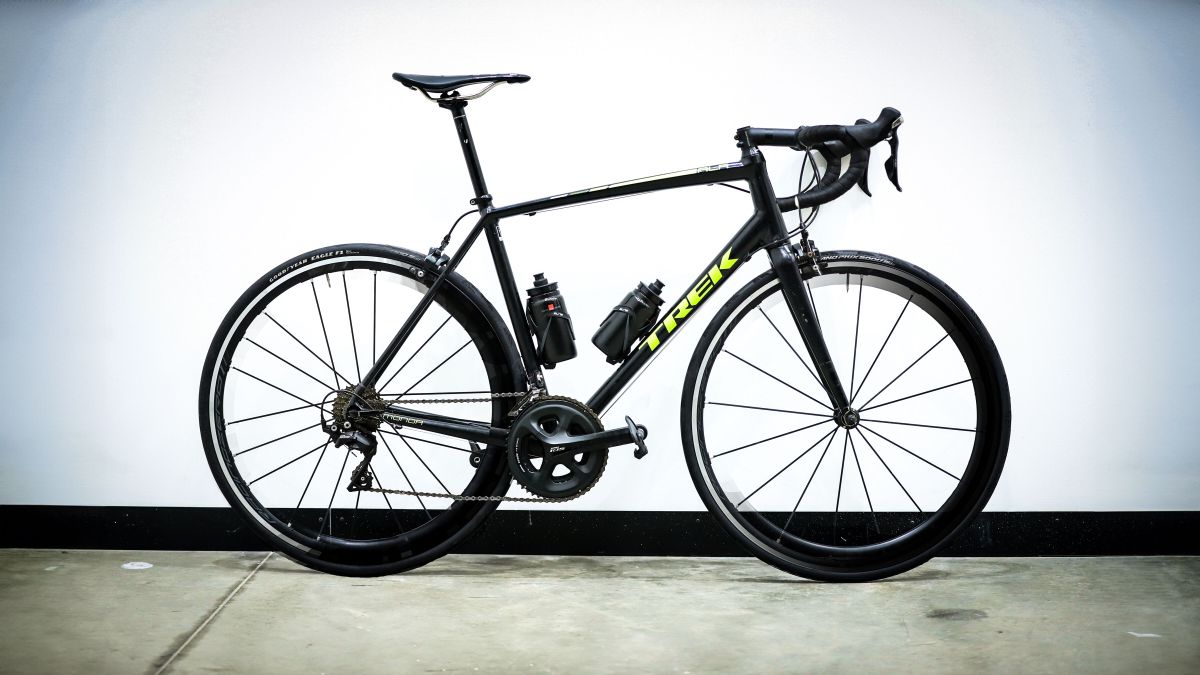
Last month, the Cyclingnews tech team spent a day in the wind tunnel at the revered Silverstone Sports Engineering Hub, putting the WorldTour's best superbikes through their paces in a head-to-head wind tunnel superbike showdown . Alongside the 11 superbikes, with their average price nearing £10,000, we also had our 'baseline' bike`: A 2015 Trek Emonda ALR complete with box section wheels, rim brakes, external cables, round handlebars, and absolutely no aerodynamic optimisation whatsoever. As you'd expect, it was slower than the superbikes.
In the raw data, taking an average of the two rider-on-bike tests we did on the baseline bike (at the start of the day and again at the end), it was 23.06 watts 'slower' at 40km/h than the average result of our superbikes. What that means is if you were to try and ride at 40km/h, you'd need to put out 23 more watts on this bike than if you were on an average superbike.

But all of our modern superbikes were equipped with deep-section aero wheels, so what happens if we swap out the wheels on our baseline bike for a similar option? We checked, of course. We wanted to know how much difference the upgrade would make. Would it close that 25-watt deficit entirely? Would it make any difference at all? Is it a better bang-for-buck upgrade than, say, a new helmet? Also, if you own an old entry-level bike like our Emonda, is an aero wheelset upgrade a good place to spend your money, or do they just look cool? Let's dig into the test and find out.
Our wheelset of choice was a fairly budget-friendly option from a now-defunct British brand Prime, an RR-50 V3 model to be precise. They were 50mm deep, with an internal width of 19mm, and we mounted the same 25mm Continental GP5000 S TR front tyre that was fitted to all other bikes on test by way of standardisation. Prior to the brand's closure, these wheels would retail for around £800.
00 / $900.00. The results We tested each bike at seven angles of yaw, which is the angle at which the wind hits the bike and rider.
A yaw angle of 0 degrees means the wind is hitting the rider straight on; a perfect headwind if you will. A higher yaw angle means the wind is coming from the side on. In this case, we tested from -15 degrees (wind coming from the left side), through to +15 degrees (wind coming from the right), in five degree increments for a total of seven captures.
The data provided by the wind tunnel is CdA, which stands for Coefficient of drag x Area. The drag coefficient reflects the shape and how easily air flows around an object, while the Area is simply its size. The lower the drag coefficient, or the smaller the object, the more easily it'll pass through the air and thus, the faster it will go for equal effort.
What's really interesting is that the deeper wheels were actually slower at lower yaw angles. This is likely due to the wheels being significantly wider than our baseline wheels, and thus simply increasing the frontal area of the bike. However, as the wind comes from wider angles, the deep wheels come into their own, offering more of a 'sail' effect, catching the wind and helping to propel the rider forward.
Having averaged the CdA values from the raw data, we found that with the deeper wheels, the rider-on-bike test provided a CdA of 0.3640. This is 0.
0062 lower (and thus faster) than the baseline. When you take those CdA values and calculate the power required at 40km/h, we start to get an idea of the difference in a real-world setting. We can see here that our superbikes require an average of 282.
41 watts to ride at 40km/h. Our baseline bike, as explained earlier, is 23.06 watts.
Interestingly, the aero wheels don't close the gap very much at all. Ignoring our error margin (which we'll get to below), the aero wheels are worth just 5.89 watts.
To help contextualise that into the real world, that equates to a saving of 25 seconds over 40km if you were riding at 250 watts, or a speed gain of 0.24km/h for equal effort. If you increase your output to 350 watts, your speed gain climbs to 0.
27km/h. However, importantly, once our error margin is taken into account, the wheels could actually be equal. The error margin for our test (which we calculated using the difference between the two tests on the identical baseline setup at the start and the end of our day), was 3.
91 watts. As shown in the two bar graphs above, the error bars for the two relevant datasets overlap each other, so comparing the best-case scenario for the baseline bike with the worst-case scenario for the deep wheels, there's a possibility that the shallow wheels are faster. Of course, error margins can work both ways, so to flip that round and take the worst-case scenario for the baseline bike and the best-case scenario for the deep wheels, the difference could be as much as 13.
7 watts at 40km/h. Conclusion Statistically speaking, due to our error margin, we cannot conclude with absolute confidence that the deep-section wheels are faster than our shallow wheels. However, looking at the raw data and using common sense, we're reasonably confident that they are.
From a cost-per-watt point of view, it's notable that the difference is so small for an item so expensive. Using the raw data, the saving is less than six watts, and going off the retail price of £800 / $900, that's £133.33 / $150 per watt saved.
What's more, when we wind tunnel tested wheels in 2022, we found that the difference between the best and worst aero wheelset was just 3.87 watts and that there was no correlation with price. This tells us the additional savings to be found by upgrading to a 'premium' aero wheelset – instead of our budget-focussed Prime wheelset here – is also small.
Perhaps most interesting of all, though, is that given most of the difference between our deep wheels and our shallow wheels is found at higher yaw angles, which are less common than low yaw angles, the real-world saving is likely even less. Of course, aerodynamic improvements aren't the only reason to buy a modern wheelset. Many of them are lighter in weight, wider and thus offer better handling, and more, but if your only motivation for wanting to upgrade to deep wheels is an aerodynamic gain, you should probably think again before investing all that cash.
.. even though they do look cool.
-.














